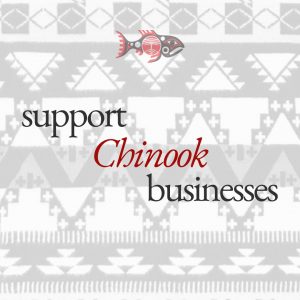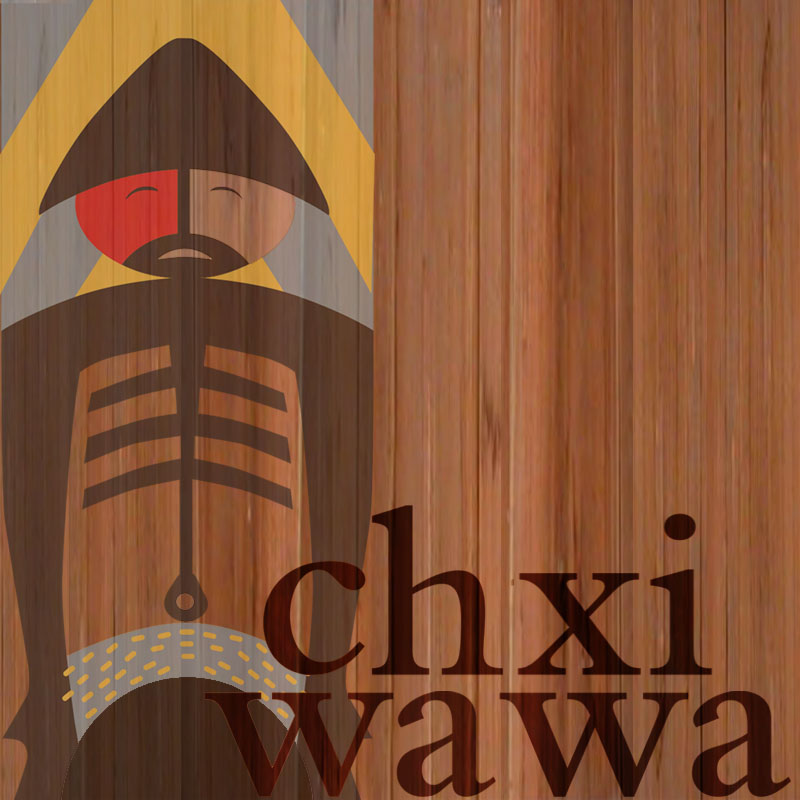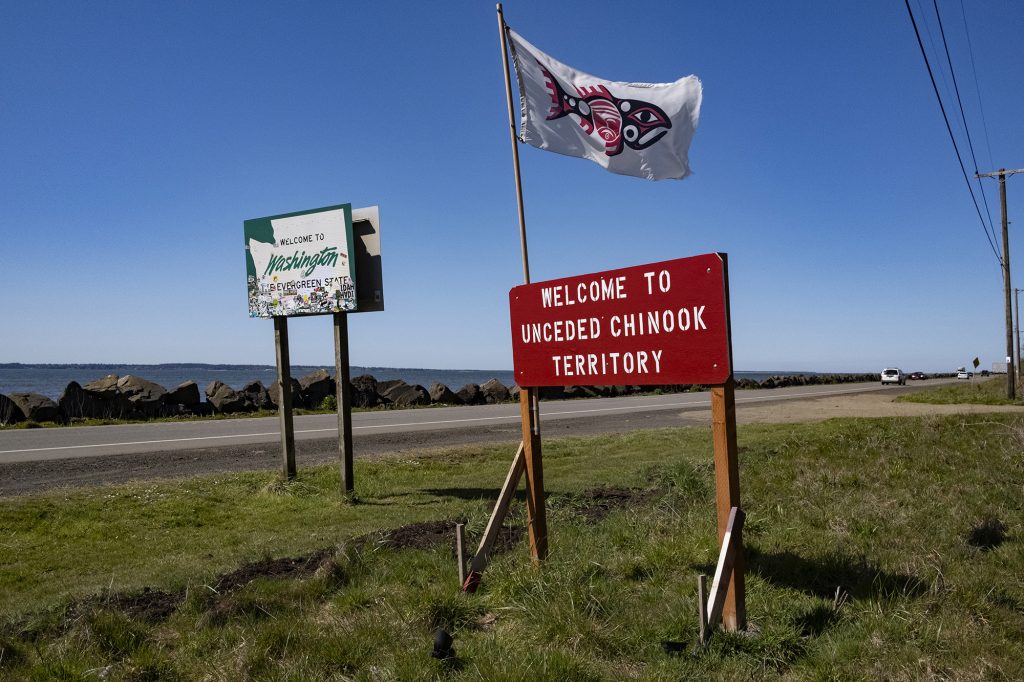
Chinook Creators and Small Businesses
Support Local, Support Chinook: Your Continually Expanding Holiday Guide to Chinook-Owned Businesses & Artists! Habitat Plants (Plants and Gifts)Melissa Adams




Support Local, Support Chinook: Your Continually Expanding Holiday Guide to Chinook-Owned Businesses & Artists! Habitat Plants (Plants and Gifts)Melissa Adams

By Cade Barker / For The Chronicle Instead of celebrating Native American Heritage Day on Friday, Nov. 29, Chinook
Chinook Indian Nation • 3 Park Street • P.O. Box 368 • Bay Center, WA 98527
© Chinook Indian Nation
photography by Amiran White
In early January 2001, a celebration was held in Washington, D.C., on the occasion of federal recognition for the Lower Band of Chinook Indians in Southwest Washington. There was cake. Tributes and congratulations were shared for a success several decades—several centuries, really—in the making. The Notice of Final Determination was published in the Federal Register, and descendants of the first people to live along the northern side of the mouth of the Columbia River reveled in the bliss of the moment.
A year and a half later, President George W. Bush held a dinner in the nation’s capital for tribal nations that had helped the Lewis and Clark expedition. Now a federally recognized tribe, the Chinook were proudly in attendance—the explorers had overwintered on Clatsop-Chinookan land. Then, two days later, the Bureau of Indian Affairs announced a reversal of federal recognition for the Chinook, a decision that stands today.
Despite having inhabited both shores of the Columbia, historically from the Pacific Coast to the Cascade Range, for more than 10,000 years, the Chinook are still not considered a sovereign tribe by the United States government.
As a result, they go without funding for essential services like health care and education. They lack resources for the preservation of their culture. And they have no say in land-use decisions on their traditional homelands. Essentially, the Chinook are still condemned to the past and its injustices. Despite a strong sense of community and morale among the Chinook today, only federal recognition can restore the Chinook as a great nation.
“Chinook has a very hard time saying that we are not federally recognized,” said Tony Johnson, chairman of the Chinook Indian Nation, which today seeks federal recognition for descendants of the Lower Columbia bands of Chinook. “We have all the issues of Indian Country and none of the means of fixing it.”
From the end of the last Ice Age to the early 1800s, the Chinook controlled a trade empire from territories just north and south of the mouth of the Columbia and upriver to the great fishing sites near present-day The Dalles. Their earliest interactions with Euro-Americans were recorded by figures like Robert Gray, who claimed the Columbia River for the United States in 1792; George Vancouver; Lewis and Clark; the Astor expedition; and photographer Edward Curtis. The Chinookan claim for federal recognition as a tribe begins here.
In the 1850s, United States treaties with different bands of the Chinook from the mouth of the Columbia—the Lower Chinook, Willapa and Wahkiakum in Washington, and the Clatsop and Kathlamet in Oregon—demanded displacement from their ancestral lands. But the Chinook refused to go, so the treaties were never signed nor ratified by the Senate.
“It’s not coincidental that Chinook is not recognized,” Johnson said. “The truth is, in some ways, it’s our decision making because our decision was that we would not leave our place. We said very clearly in those treaty negotiations, we were staying with the bones of our ancestors, and we were going to be buried alongside them.”
By the time of the treaties, epidemics had reduced Chinookan populations so severely, up to 90 percent, that Chinook from both sides of the Columbia River either relocated to live with relatives on nearby reservations like at Quinault, or they stayed home and formed part of the new community.
In the early twentieth century, various groups of Chinook pursued some form of recognition. Land claims settlements were awarded, for example, and some Chinook were granted individual Indian money accounts and Indian “blue card” permits for hunting and fishing. Then, in the 1950s, the federal government terminated the recognition of tribes in Western Washington and Western Oregon, which included any dealings with the Chinook.
“To this day, the Bureau of Indian Affairs manages Indian money market accounts and probates the estates of Chinook Indians, even though they’re not recognized as the member of a tribe, which is mind-boggling,” said Stephen Dow Beckham, professor emeritus of history at Lewis & Clark College in Portland.
Beckham spent twenty years helping research, write and submit the Chinook petition for federal recognition that was approved in 2001. During that time, Beckham witnessed firsthand what he called the “duplicity” and “incompetence” of the federal-recognition process. Today, Beckham has no doubts about the legitimacy of the petition he wrote, but he has had no involvement with the Chinook since 2001.
Just before federal recognition was granted in 2001, opponents of the pending decision seized on the tumultuous post-contact history of the Chinook to discredit them. Foremost among these was the Quinault Indian Nation, which spent several hundred thousand dollars to legally challenge the federal recognition of the neighboring Chinook and Cowlitz tribes, on the grounds that neither had maintained a politicocultural presence on the landscape. The Cowlitz prevailed, but the Chinook did not.
The explanation for Quinault opposition lies especially in the ownership of valuable allotments on the Quinault Reservation. In 1932, the Chinook, Cowlitz and Chehalis Indians who resided on the Quinault Reservation won a Supreme Court case that awarded them the right to 80-acre land allotments there. Although not enrolled in the Quinault Indian Nation, these three tribes did vote to create a confederation of tribes, but the Quinault refused to comply. With 55 percent of the allotments still in Chinookan hands, the Quinault fear that a federally recognized Chinook Nation would have influence over Quinault affairs.
“These issues are volatile,” Beckham said. “They were extremely volatile twenty-five years ago, and they definitely clouded or affected the reversal of the decision on the Chinook petition.”
For Jon Daehnke, associate professor of anthropology at the University of California, Santa Cruz, and author of Chinook Resilience: Heritage and Cultural Revitalization on the Lower Columbia River, such pitfalls are vestiges of colonialism. “In a lot of ways, it worked better for the federal government to get these communities fighting with each other,” he said. “These hostilities or disagreements are always centered on trying to take resources from people.”
Besides what he calls a lingering “anti-Indian” sentiment, Daehnke believes the federal government is concerned about what must be given, and about what would be lost in such a strategic and resource-rich area as the mouth of the Columbia River. He also considers the concerns of neighboring recognized tribes in Washington and Oregon and what toeholds they might lose if the Chinook are federally recognized. “There are no tribal communities elsewhere in the Pacific Northwest that are saying these people aren’t Chinook,” he said.
Apart from unresolved issues with some of its neighboring tribes, and indifference on the federal level, recognition for the Chinook Indian Nation faces challenges due to the breadth of its claim. While the petition Beckham helped prepare only applied to the Lower Band of Chinook in Washington’s Pacific County, today’s push for recognition includes five bands of Chinook, on both sides of the Columbia River. Further, the two Oregon bands were officially terminated in 1954 and are prohibited from reapplying for recognition.
Historically, the various bands of Chinook shared cultural and familial ties, but they were never organized as a single tribe or nation. In ancestral Chinookan territory, as along the entire West Coast, autonomous villages formed the political unit, each with its own leader. Treaty negotiations in the 1850s therefore had to deal with the different bands of Chinook individually. Historians and anthropologists still consider Chinookan a linguistic term, not a geopolitical one.
Chairman Johnson disagrees. He views the Columbia River as an arbitrary border. Both he and his wife, like many of the 3,300 enrolled members of the Chinook Indian Nation, draw their ancestry from various bands of Chinook and from neighboring tribes in Oregon and Washington due to centuries of intermarriage, including with Euro-Americans. For Johnson and the Chinook Indian Nation, regardless of the written historical record, today’s Chinookan descendants are one.
“We are the people from this place,” Johnson said. “The paths that we’re on are political. We operate as, and have a full expectation of being treated as, a sovereign nation at the mouth of the river. We have that expectation in terms of how people treat us, and most organizations, entities and governments do treat us that way.”
In the most important ways, the Chinook are already living as a recognized tribe. They are a tight community, always helping one another. They participate in Tribal Journeys, a multi-tribe canoe excursion, paddling cedar canoes they have hewn in the same fashion as their ancestors. They celebrate a First Salmon ceremony each spring and are reviving their language and art forms. “Everyday Chinook,” they call it—living Chinook all day, every day of their lives.
Still, federal recognition provides benefits and status of significant proportions. “When you don’t have federal status and you’re amongst other federally recognized tribes, sometimes you’re looked down on, you’re not equal, and that hurts,” said vice-chairman Sam Robinson, who has been on the entirely volunteer-presided Chinook Tribal Council since 2002, and who served four years in the U.S. Army. “To go back to when we were all equal, before there was federal status, when we’re all tribes and we’re equal, would be really good.”
Federal recognition would restore Chinookan rights to hunt and fish and to be consulted on archeological and cultural resource projects in their traditional territory. It would include them in the Native American Graves Protection and Repatriation Act. Most importantly, recognition would benefit the Chinook in key areas like health care and education. “As a tribal leader, it’s been very difficult not being able to provide for our people,” Robinson said. “The more we can provide for ourselves, the better off we are, and the more we’ll be able to provide for others as well.”
Mental health has an added dimension in Indigenous communities, the Chinook included. From the 1880s through the 1920s, Indian boarding schools took children from their homes to be raised according to traditional American values. The trauma of such separation from family, community and culture, and the terrible experiences lived at boarding school, have left emotional scars that are passed down through generations.
“One of my great frustrations, and one of the reasons why Chinook has to be recognized, is because we were Native enough to drag us off and cause all that harm in the community,” Johnson said. “Well, then we sure as hell better be Native enough to get the recognition that will allow us access to resources to heal from it, to move forward like the rest of the communities are trying to do.”
The Chinook are thankful to have allies near home who embrace them as a tribal nation. These include recognized tribes like the Shoalwater Bay Indian Tribe in Washington and the Confederated Tribes of Grand Ronde in Oregon, where many Chinook descendants have lived for generations. Other important relationships are emerging with non-tribal institutions.
In November 2024, the Chinook Indian Nation signed a memorandum of understanding with Columbia Land Trust, a conservationist landowner in traditional Chinook territory that formally supports federal recognition for the Chinook. Their partnership seeks to protect, co-manage and provide access to areas deemed important by the Chinook, and to help them in the process of recovering some of their ancestral lands.
“In speaking about Chinook restoration over the years, I talk about the importance of having a federally recognized tribe in your backyard, and how important it is to Mother Earth because we’d be able to help take care of her with that status,” Robinson said.
Recognition would provide the Chinook with resources to acquire land and hire staff. It would also give them a seat at the table for local land management. Columbia Land Trust Conservation Director Cathy Kellon is well aware of the invaluable contribution that the Chinook can give to the land. “There is a knowledge and understanding of a place that comes with being the original stewards, and there’s no substitute for that,” she said.
In Astoria, the Columbia River Maritime Museum overlooks the river’s bay-like mouth, where ships come and go constantly, and where Chinookan canoes once did the same for millennia. Five years ago, the museum began working with the Chinook to include their story. The newly opened Chinook exhibit, which includes Chinookan canoes when they’re not in use, serves as a welcome to the Chinookan homelands and to another exhibit, Cedar and Sea, that presents the Indigenous maritime cultures of the Pacific Northwest Coast.
Bruce Jones, the museum’s executive director, said he made a commitment to the Chinook that they would always have a presence there. The museum would be incomplete without a Chinook exhibit, he said, which helps expand awareness to tourists and locals alike.
“When people hear the live voices in the exhibit’s videos, it’s just a reinforcement of the fact that this is not a historical exhibit,” Jones said. “These are people living and breathing today in our community that are members of the Chinook Indian Nation. They’re talking to us in 2025 about what the culture means today.”
“I can’t tell you how proud it makes me to come up the highway and see this giant billboard for the exhibit saying, ‘This is Our Place,’ with a picture of a Chinook canoe on it, marking our territory and letting people know that we’re still here, still doing the ways of our ancestors,” Robinson said.
The awareness created through exhibits and partnerships generates momentum in society, both locally and beyond. One direction for this momentum is political—putting pressure on the federal government to recognize the Chinook. As Daehnke noted, “When people hear more and more about this story, they more and more ask, ‘What the hell? We know these people, they’re our neighbors, and they’re important people in our community, and we know this landscape. Why is this not happening?’”
The Chinookan push for federal recognition dates back nearly 200 years. Progress seems limited, but the Chinook see signs of promise. For instance, in February 2024 the BIA released nearly $700,000 to the Chinook Indian Nation that had been held by the government since 1970. These funds, originally totaling $48,000, were won in a land claims settlement but were never distributed because there was no federally recognized tribe to receive them.
Ultimately, federal recognition of sovereign status is a question of diplomacy. Several ways forward exist, each with its own political or bureaucratic complications: Congress could pass a bill, the Office of Federal Acknowledgement could approve the petition, or presidential executive order could be given.
Today, the Chinook have political allies in Washington State, Oregon and Washington, D.C. Ever since the reversal of recognition in 2002, congresspeople in Washington State have proposed legislation and endorsed recognition for the Chinook. Following reelection in 2024, U.S. Representative from Southwest Washington Marie Gluesenkamp Perez has made the push for Chinook recognition part of her agenda and is currently working on a new bill for Congressional approval.
“Federal recognition would grant the tribe a government-to-government relationship with the United States and begin to right the wrongs the Chinook people have endured for generations,” she said in a statement. “We are continuing to build buy-in and consensus from local stakeholders and tribes to be able to get recognition legislation across the finish line—that way the Chinook Indian Nation can access long-awaited resources and opportunities.”
The Chinook see recognition as a benefit not just to the tribe but to all of Southwest Washington. With a centralized government, complete with robust tribal agencies and any potential business ventures, the Chinook would become a major employer in the region. The economic opportunities and benefits would extend well into non-tribal communities.
“We want to be good neighbors,” Robinson said. “I like to remind people that in 1889, it wasn’t the Evergreen State, it was the Chinook State. We could step up and help out again. We’re here, you know. We’re not going away.”